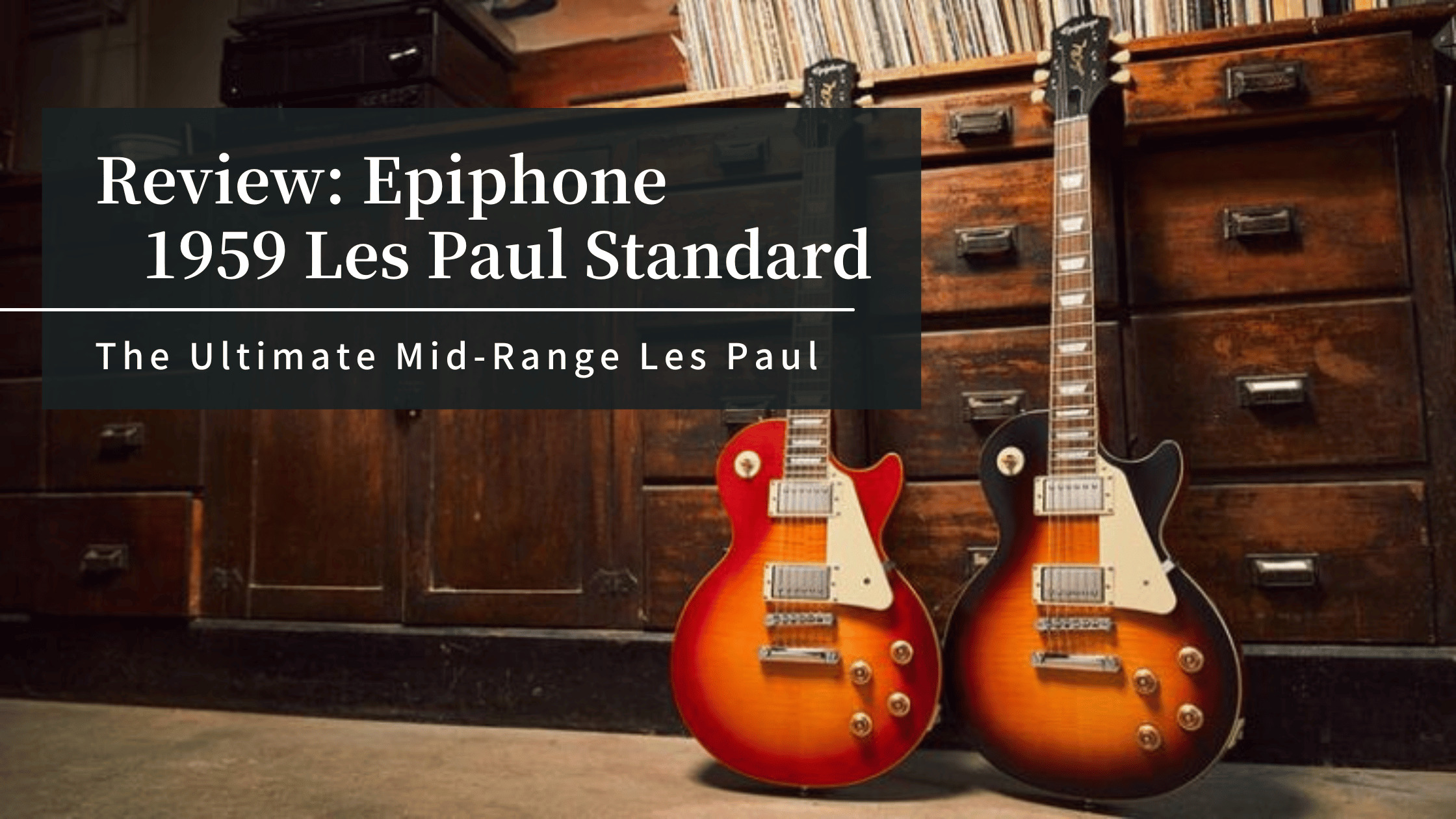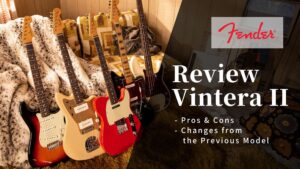The article provides a comprehensive review of the Epiphone 1959 Les Paul Standard, a mid-range guitar developed in collaboration with the Gibson Custom Shop. Epiphone 1959 Les Paul Standard offers several features such as high playability, a long-tenon joint structure, and a Gibson equivalent electrical system. However, it does have some disadvantages, including inferior quality to Gibson and low fidelity as a 1959 reissue. The article also compares the Epiphone 1959 Les Paul Standard with the Epiphone Les Paul Standard 50s. Despite the price difference, the 1959 Les Paul Standard is recommended for those who can afford it.
Hello, I’m Yosh, an ex-music store clerk (@Yosh_Guitar). The Epiphone 1959 Les Paul Standard is recommended for those who:
- Find Gibson too expensive
- Appreciate the classic look of a Les Paul Standard
- Are looking for a second Les Paul guitar
This is the ultimate mid-range Les Paul, developed in collaboration with the Gibson Custom Shop. I will thoroughly explain the reasons for this.
Pros
- A cheaper mid-range Les Paul Standard than Gibson
- High playability due to Epiphone’s top-grade
- Long-Tenon Neck Joint for good sound
- Gibson equivalent electronics, such as Burst Bucker PU
A cheaper mid-range Les Paul Standard than Gibson
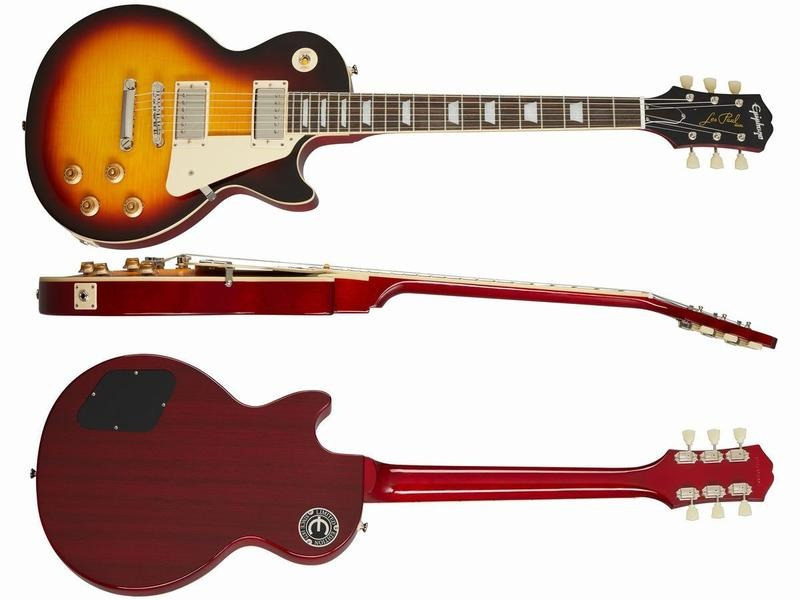
The cheapest class of Gibson is obviously a cost-cut Les Paul Tribute with no flame top and no binding, making it hard to call it a traditional Les Paul Standard. This axe, which looks like a traditional Les Paul Standard and costs under $1,000, is attractive.
High playability due to Epiphone’s top-grade
When you hear Epiphone, you might think it’s just Gibson’s second brand, and the quality is not good. However, this Epiphone 1959 Les Paul Standard is clearly of higher quality than the cheaper Epiphones before, considering its class of $1,000. Specifically, it is the point where meticulous handwork is properly applied. This is an impression of quality beyond the cheap Gibson mentioned earlier. The nut treatment is appropriate, the low chord is easy to press, and the edges of the fret side and neck are smoothly rounded, so the grip is good. The frets are medium jumbo, and the distance between the strings and the frets is close, so no unnecessary force is needed for pressing the strings. Also, the neck shape reproduces the 59 model, which can be said to be intermediate between the very thick 58 model and the thin 60 model. It has a good thickness and grip, and is friendly to all players, and it has a good impression of thickness in terms of sound.
Long-Tenon Neck Joint for good sound
One of the elements that was said to be superior to the original Gibson in the made in Japan Les Paul a while ago, the deep joint (long tenon) structure is also adopted in this machine. Of course, the 1959 model also has this structure. By increasing the installation area of the joint part, the strength of the joint increases, and the string vibration is firmly transmitted to both the body and neck, producing a sound with a core.
Gibson equivalent electronics, such as Burst Bucker PU
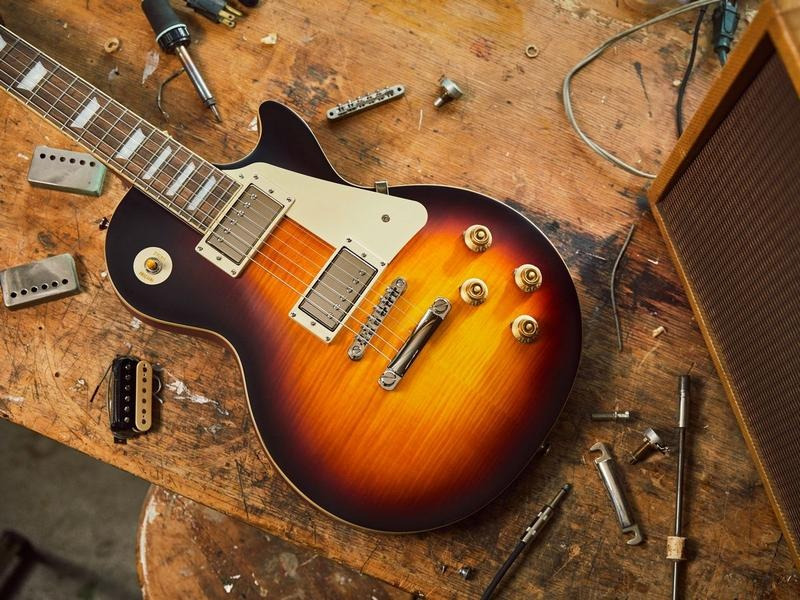
In the electrical system centered on the pickup, which is one of the important elements in the sound of an electric guitar, the same as the original Gibson is adopted. The pickups are equipped with a BurstBucker 2 in the neck position and a BurstBucker 3 in the bridge position. Gibson’s BurstBucker pickup is designed in a modern way based on the vintage PAF, and it has a sound like a Gibson humbucker, but with a moderate power, it can handle various genres. The pots are also made by CTS in the USA, like Gibson, and the jack and toggle-switch are also equipped with Switchcraft. The condenser uses Mallory. The sound grade is clearly higher than the conventional Epiphone. In addition, the wiring of the volume and tone circuits is the same as the 50-year-old vintage, so the treble does not cut off even if the volume is reduced. However, the volume decreases when the tone is reduced.
Cons
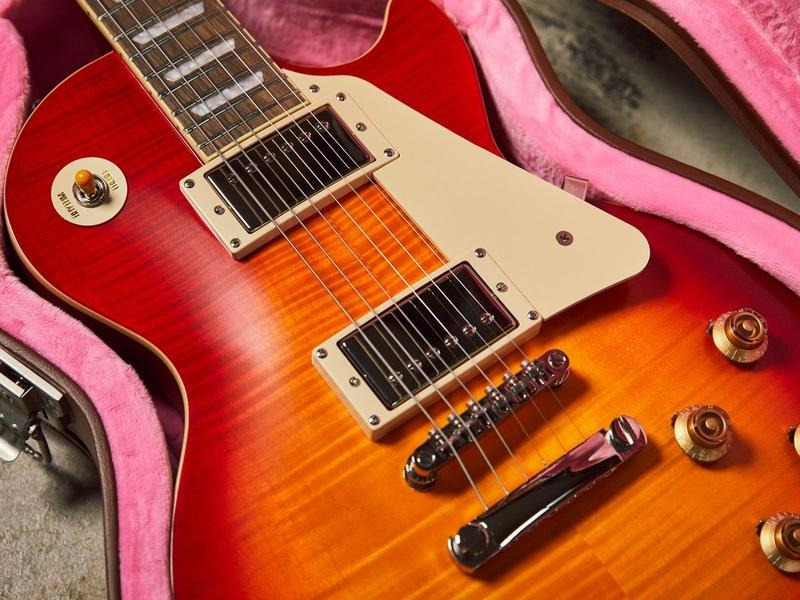
- Inferior quality to Gibson
- Low fidelity as a 1959 reissue than Gibson Custom Shop
Inferior quality to Gibson
It is better than a cheapest Gibson’s appearance – Les Paul Tribute. Although the original Gibson Les Paul Standard is a cut above. The rosewood fingerboard, parts such as pegs and bridges, the sexy gloss of lacquer paint, and the setup by Plek, all contribute to a sound that is indeed Gibson. However, it is natural that there is a price difference of more than $2,000, which is more than double. The semi-gloss finish of Epiphone is a calm and dignified look compared to the shiny new Gibson, and this is a matter of preference. Unfortunately, the AAA grade maple is a very thin veneer, and the laurel fingerboard material must be said to be for cost cutting. There is no disadvantage in terms of sound because hard maple is pasted under the veneer.
Low fidelity as a 1959 reissue than Gibson Custom Shop
The most popular 59 model Les Paul among vintage Les Pauls. It’s attractive to have its name, but it’s not high in terms of reproduction. For example, the bridge and tailpiece that can be fixed so that they do not fall off even when changing strings, and the medium jumbo frets that are easy to press because of their large size. However, these are modern upgraded parts that are easy to handle, so if you are not a vintage believer, you can welcome them. The head shape has also become cooler than the old Epiphone, so I personally don’t mind, but it has been a target of denial from fundamentalists.
Comparison with Epiphone Les Paul Standard 50s
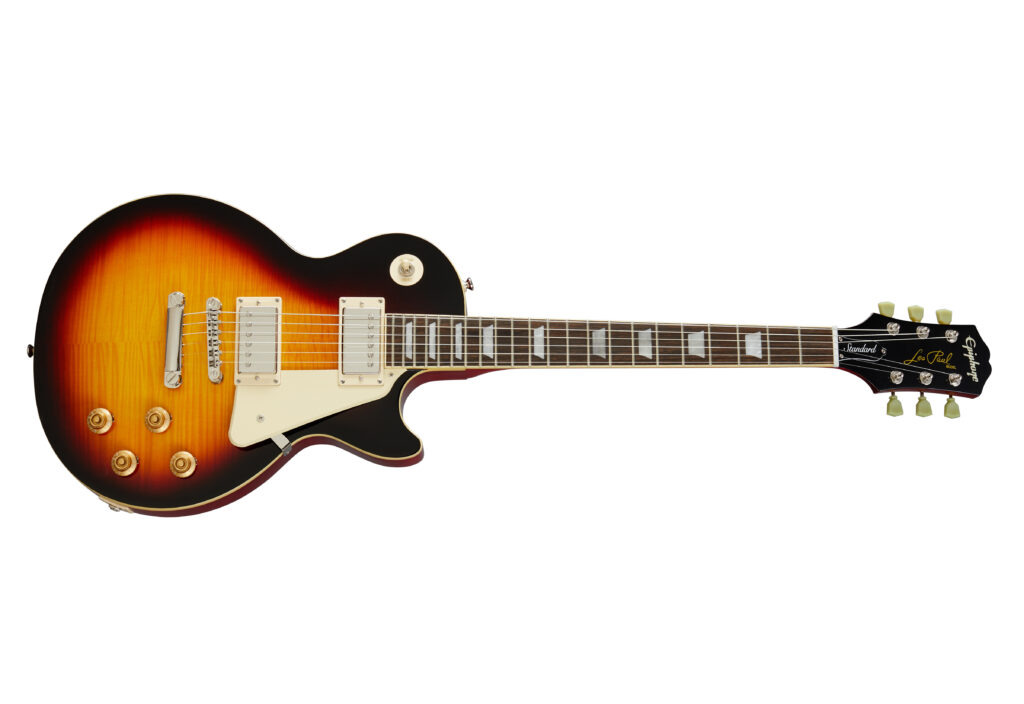
| 1959 Les Paul Standard | Les Paul Standard 50s | |
|---|---|---|
| Market Price | $999 | $699 |
| Body Top | Carved Hard Maple Cap with AAA Figured Maple Veneer | Carved Hard Maple Cap with AAA Flame Maple Veneer |
| Body Back | Mahogany | Mahogany |
| Finish | Aged Gloss | Gloss |
| Neck Shape | 50s Vintage 1959 hand-rolled neck profile | 50s Rounded Medium C |
| Joint | Glued in, Long Tenon | Glued in |
| Scale Length | 629.0 mm / 24.763 in | 628.65 mm / 24.75 in |
| Fretboard Material | Laurel | Laurel |
| Fretboard Radius | 304.8 mm / 12 in | 304.8 mm / 12 in |
| Nut Material | Graph Tech® NuBone® | Graph Tech® NuBone® |
| Nut Width | 43.0 mm / 1.692 in | 43.0 mm / 1.692 in |
| Bridge | Epiphone LockTone™ ABR-1 | Epiphone LockTone™ Tune-O-Matic™ |
| Tailpiece | Epiphone LockTone™ Stop Bar | Epiphone LockTone™ Stop Bar |
| Tuning Machines | Epiphone Deluxe with Vintage Tulip Keys | Epiphone Vintage Deluxe 18:1 ratio machine heads |
| Control Knobs | Gold Top Hat with dial pointers | Gold Top Hat |
| Neck Pickup | Gibson BurstBucker™ 2 | Epiphone ProBucker™ 1 |
| Bridge Pickup | Gibson BurstBucker™ 3 | Epiphone ProBucker™ 2 |
| Controls | 2 Volume, 2 Tone, CTS® pots, Mallory capacitors, 50s era wiring | 2 Volume, 2 Tone, CTS® pots, 50s style wiring |
| Pickup Selector | 3-way Switchcraft® toggle | 3-way Epiphone toggle |
| Jack | 1/4” Switchcraft | 1/4” |
| Accessories | Hardshell Case, Epiphone Limited Edition metal medallion toggle switch back plate | Gigbag |
1959 Les Paul Standard can be said to be a higher model of the Epiphone Les Paul Standard 50s. The looks, sound, and playability have been improved.
- Looks: 1959 Les Paul Standard has an aged finish like Gibson’s VOS. It has a high-quality texture and feels good to the touch. The 50s has a plasticky poly finish.
- Sound: With the deep joint neck and Switchcraft electrical parts, 1959 Les Paul Standard is equipped with Gibson BurstBuckers. It outputs a rich Les Paul sound that is not inferior to Gibson, with high resolution. The output is also slightly higher, so it goes well with distortion. The Les Paul Standard 50s sound feels a bit more flat.
- Playability: 1959 Les Paul Standard has a smooth and easy-to-grip neck shape. Compared to the Les Paul Standard 50s, the handwork process has been increased, and the edges of the frets and neck are smoothly rounded.
There is a difference of several hundred dollars, but if you can afford it, 1959 Les Paul Standard is definitely recommended. If it’s the first one to buy for beginners, Les Paul Standard 50s would be good.
Conclusion
In this video, They compare Epiohone 1959 with the Gibson Custom Shop. The Custom Shop has a feeling of harmonic richness and range, but the fact that there is no clear superiority shows the high completion level of Epiphone.
What I felt when I tried the actual Epiphone’s is that the playability is not as high-end as a guitar. However, the original Gibson Les Paul is not a high-end modern guitar with stress-free playability. In other words, there is not a big difference in the ease of playing with Gibson, and of course it is easier to play than a guitar in the around hundreds dollars range. The sound is also a sweet and rich sound due to the solid body and humbucker, which is a sound that is just a Les Paul.
In short, it is recommended as a middle-class Les Paul that combines sound, playability, and looks at an affordable price.
Epiphone 1959 Les Paul Standard is recommended for people who:
- Find Gibson too expensive
- Like the look of a traditional Les Paul Standard
- Want to replace a beginner’s guitar
- Already own a Fender style and want a Les Paul as second guitar
- Want a humbucker sound to use in traditional genres such as blues and rock
Spec
- Body Top: AAA Maple Veneer + Hard Maple
- Body Back: Mahogany
- Neck: Mahogany
- Neck Shape: 1959 Hand-rolled Neck Profile
- Scale: 24.76″ / 629mm
- Fretboard Radius: 12 inches
- Frets: 22 Medium Jumbo
- Nut: NuBone
- Nut Width: 1.69″ / 43mm
- Bridge: Epiphone LockTone ABR-1
- Tailpiece: Epiphone LockTone Stop Bar
- Pegs: Epiphone Deluxe with Vintage Tulip Keys
- Pickups: Gibson BurstBucker 2/3
- Colors: Aged Dark Burst, Aged Dark Cherry Burst
- Case: Hard case
- Market Price: Around $1,000
This model was born from a collaboration between the Gibson Custom Shop and Epiphone to commemorate the 60th anniversary of the most popular vintage Les Paul from 1959. The overall specs are vintage-like from 1959, but there are also parts that are arranged to be easy to handle. It also comes with a hard case with a pink inner and brown exterior.

